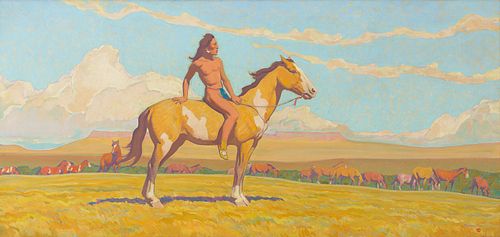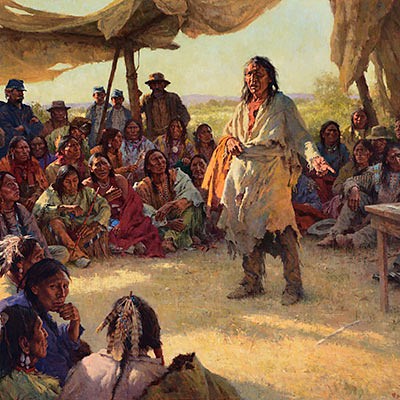Maynard Dixon (1875 – 1946) — The Pony Boy (1920)
About Seller
11944 North Tracey Road
Hayden, ID 83835
United States
Coeur d’Alene Art Auction specializes in the finest classical Western and American Art representing past masters and outstanding contemporary artists. The auction principals have over 100 years of combined experience in selling fine art and have netted their clients over $325 million in the last fif...Read more
Two ways to bid:
- Leave a max absentee bid and the platform will bid on your behalf up to your maximum bid during the live auction.
- Bid live during the auction and your bids will be submitted real-time to the auctioneer.
Bid Increments
| Price | Bid Increment |
|---|---|
| $0 | $100 |
| $2,000 | $250 |
| $5,000 | $500 |
| $10,000 | $1,000 |
| $20,000 | $2,500 |
| $50,000 | $5,000 |
| $100,000 | $10,000 |
| $200,000 | $25,000 |
| $500,000 | $50,000 |
| $1,000,000 | $100,000 |
About Auction
Jul 15, 2023
The 2023 Coeur d’Alene Art Auction, to be held July 15 in Reno, Nevada, will feature 324 selections of unparalleled quality in Western & American Art from historical and contemporary artists such as Maynard Dixon, Howard Terpning, W. Herbert Dunton, Joseph H. Sharp, Charles M. Russell, and more. Coeur d'Alene Art Auction info@cdaartauction.com
- Lot Description
Maynard Dixon (1875 – 1946)
The Pony Boy (1920)
oil on canvas
36 × 72 inches
signed and dated lower right
VERSO
Signed, titled, and “#140”
Label, Christie’s, Los Angeles, California
Label, Laguna Beach Museum of Art, Laguna Beach, California
Label, Santa Barbara Museum of Art, Santa Barbara, California
According to Dixon biographer Donald J. Hagerty, “In July 1917, the Great Northern Railway, through the efforts of Foster and Kleiser, a prominent San Francisco advertising company specializing in outdoor billboards, and which artist Maynard Dixon had joined the year before, approached him with a proposal to paint in Glacier National Park and on the Blackfeet Reservation, the railroad’s premier tourist destinations. The railroad envisioned Dixon’s artwork would be used as part of their ‘See America First’ campaign and others used as promotional posters for distribution in California. Dixon, eager to escape the aftermath on a difficult divorce quickly accepted the offer. He then wrote to Frank B. Hoffman, a painter and illustrator he had known while working in New York from 1907 to 1912 to join him. Hoffman, already working in Glacier, readily agreed. Familiar with the Park’s backcountry, he would serve as a guide. The Park Saddle Horse Company provided Chick Grimsley who would serve as the trail boss and packer.
“Accompanied by his seven-year-old daughter Constance, Dixon arrived in Glacier in mid-August 1917. Dixon and his group explored Glacier’s dramatic alpine views and stopped by to visit Charles M. Russell at his lodge on Lake McDonald. By late September, the group moved on to the Blackfeet Reservation, pitching their camp among the lodges of six Blackfeet families on the north fork of Cut Bank Creek where the flanks of Glacier National Park meet the rolling prairie. There they were welcomed by Owen Heavy Breast, Curly Bear, Two Guns White Calf, Lazy Bear, and others who sang, told stories and served as models for Dixon. Some could recall their life in the waning days of the Northern Plains horse and buffalo culture. At the encampment, Dixon worked furiously, energized by the hospitality of his hosts and buoyed by the escape from San Francisco’s noise and turmoil of daily life. The Blackfeet in turn, welcomed the tall, spare man and his young daughter. A keen and compassionate observer, Dixon roamed the camp photographing or sketching people engaged in daily activities as well as the camp itself with its yellow cottonwood trees and rust-red willows and smoke-toned teepees sharp against the sky. The camp residents invited Dixon to Grass and Scalp Dances and to the initiation of new members into the Brave Dog Society, and he and Constance were the only guests at a Beaver Medicine ceremony.
“While most of Dixon’s time was spent with the Cut Bank group, he periodically ventured to agency headquarters in Browning, Montana, to draw and paint the Blackfeet who gathered there. At other times, Dixon took solitary rides for miles over the open prairie, reveling in the smell of the air and the vast roll and heave of the landscape. The Dixon’s stay on Cut Bank Creek finally drew to an end in early October as snow and biting cold weather arrived and the lodge fires breathed blue-white smoke into the frosty mornings. Dixon and his daughter reluctantly returned to San Francisco. Constance recalled she was heartbroken to leave her Blackfeet friends. Dixon, revitalized by his experiences among the Blackfeet brought back a memento from their stay – a Blackfeet teepee. During his two months stay at Glacier and on the Blackfeet Reservation, Dixon created numerous small oil sketches and drawings, templates for larger works which he would do in his San Francisco studio. For a number of years after his visit, Montana, and particularly Blackfeet subjects continued to echo in his memory and influence his art.
“In 1920, Dixon created a painting unlike any he had painted before, the startling three by six-foot The Pony Boy, something more abstract and spiritual, a new template in his art that bridged his passionate interest in Indian cultures and selective aspects of modern art. Although often held captive by the myth and romantic spell of the ‘Old West,’ he knew that the ‘old campfires’ were flickering out and a New West was arriving with the automobile and tourism – along with new painting styles. The painting’s inspiration actually began in 1915, five years earlier. Dixon was commissioned to design a poster for The First Annual Horse Show in February 1915, a benefit for the People’s Place. In the middle of the poster reside the first image of what would become The Pony Boy. Sometime in 1920, Dixon began work on the painting guided by the image on the poster and the stories told to him during his stay among the Blackfeet. Dixon’s painting style and technique left the impressionism and post-impressionism of previous works, moving toward a simplified realism with cleaner colors and more firmly constructed images. Though still enthralled with romantic ideals his themes now were marked by a new, more forceful approach with The Pony Boy leading the way.
“The painting projects a feeling of freedom and space as the Plains Indians must have known it when they roamed the Montana prairie. The completed painting depicts a Blackfeet boy astride his Pinto pony, at ease in the stir of light air against the backdrop of a pony herd and distant buttes. There is an enthusiasm for mixing color by placing the ponies of red and yellow and the Pinto horse among gold grasses and green sagebrush, all set against the blue air of foothill shadows. The technique of building form on the canvas with color, applied with a strong structural feel, extends The Pony Boy beyond the physical constraints of the frame, suggesting open space, freedom, and a big world.
“Shortly after World War I, Dixon confronted modernism, analyzing what could be used in his art. Intrigued, yet skeptical with some of the movement’s ideas, Dixon joined his landscapes, murals, and some figurative work to the concept of Dynamic Symmetry giving his work a fresh and contemporary look. Never widely accepted in American art, it was based on a mathematical composition, attempting to discover in nature a set of geometrical relationships and apply them to painting. Dixon scoffed at the mathematical premise but developed his own modified version of lines and points as guides for creating a composition. Through his trademarks of a low, far horizon, a blending of planning, spontaneity and subjection of detail to larger effects, a readily identifiable synthesis emerged.
“Dixon’s capacity for artistic growth, an ability to develop a new rationalized and reflective imagery is evident in reviews he started to receive after The Pony Boy appeared in several gallery exhibitions. Gene Hailey, an art critic for The Wasp commented, ‘In his larger works we find marked proof that he had absorbed and digested the intent of the newer movements and unfoldments of modern art; vivid color, simplified form, and a large decorative impulse intensify The Blue Canyon and The Pony Boy. In this broader scope he is as faithful as ever to his Western life, as accurate as to types and locality, but handling them in a new way. Dixon paints the West, his country, yet beyond the incidental phases, the entire work shows discernment, grasp, and power of adaptation which prove the artist to be leaps ahead of those who are content with imitative realism. All of which assures verification and security of position for his work in the world of art.’
“Dixon wrestled with the implications of modernism on his art, but did not shun modernist views. He believed in the sure inspiration of nature but made emphatic statements that championed more abstraction in his painting. This is evident in The Pony Boy.”
PROVENANCE
The artist
Mr. and Mrs. William H. Hoffman, Jr., 1921
The Katherine H. Haley Trust, Ojai, California, by descent
Christie’s, Los Angeles, California, 2000
Private collection, Wyoming
EXHIBITED
S. & G. Gump and Company, San Francisco, California, 1920
Francis C. Orr Gallery, San Diego, California, 1921
Stendhal Galleries, Los Angeles, California, 1921
Biltmore Salon, Los Angeles, California, 1924
Masters of the West, Santa Barbara Museum of Art, Santa Barbara, California, 1971
Maynard Dixon Retrospective Exhibition, California Historical Society, San Francisco, California, 1975
Southern California Artists: 1880-1940, Laguna Beach Museum of Art, Laguna Beach, California, 1979
Maynard Dixon: Images of the Native American, California Academy of Sciences, San Francisco, California, 1981
Art of the American West from County Collections, Ventura County Historical Museum, San Buenaventura, California, 1985
LITERATURE
The San Francisco Chronicle, November 1920
The San Francisco Examiner, 1920
Los Angeles Evening Express, March 1921
The San Diego Evening Tribune, 1921
Wesley M. Burnside, Maynard Dixon: Artist of the West, Brigham Young University Press, 1974, pp. 15, 17, 67, 69, 161, illustrated
Maynard Dixon: Images of the Native American, California Academy of Sciences, 1981, p. 18, illustrated
Art of the American West from County Collections, Ventura County Historical Museum, p. 3
Southwest Art, June 1988, pp. 28-29, illustrated
Donald J. Hagerty, Desert Dreams: The Art and Life of Maynard Dixon, Gibbs Smith, 1993, pp. 103-04, 131, illustrated
Donald J. Hagerty, The Art of Maynard Dixon, Gibbs Smith, 2010, pp. 74-75, 77, 110, illustrated
View More InformationCondition
Surface is in excellent condition. Canvas is lined. Specks of inpainting in sky and around edges of frame.
- Buyer's Premium



 EUR
EUR CAD
CAD AUD
AUD GBP
GBP MXN
MXN HKD
HKD CNY
CNY MYR
MYR SEK
SEK SGD
SGD CHF
CHF THB
THB













